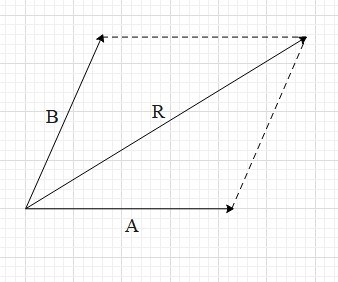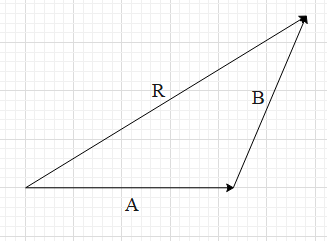
State and prove parallelogram law of vector addition.
Answer
576.9k+ views
Hint: The parallelogram of vector addition is used to find the resultant of two given vectors with the help of a parallelogram drawn by considering the two vectors as the adjacent sides of the parallelogram. To prove this law use the triangle law of vector addition.
Complete answer:
When we want to find the resultant of two vectors, we use the parallelogram law of vector addition. The parallelogram law of vector addition says that the resultant vector of two vectors is along the one of the diagonal of the parallelogram formed when we consider the length of two vectors as adjacent sides of the parallelogram.
To understand the statement in a better way, look at the figure below.

To use the parallelogram law, the tails of the both vectors (A and B) must join as shown. Complete the parallelogram by considering the two vectors as the adjacent sides of the parallelogram. Then the resultant (R) of two vectors will be along the diagonal that passes through point O, as shown in the figure.
Let us now prove this law. For this we will use the triangle law of vector addition.
According to triangle law, the resultant R between vectors A and B is shown as:

And if we complete the parallelogram by considering the lengths of vectors A and B as adjacent sides of the parallelogram, then we can see that the resultant R becomes the diagonal of the parallelogram

Hence, the parallelogram law of vector addition is proved.
Note:
When we think about the two laws of vector addition, both laws are similar. However, the parallelogram of vector addition is most commonly used. Because with the parallelogram law we can find the magnitude of the resultant.
Complete answer:
When we want to find the resultant of two vectors, we use the parallelogram law of vector addition. The parallelogram law of vector addition says that the resultant vector of two vectors is along the one of the diagonal of the parallelogram formed when we consider the length of two vectors as adjacent sides of the parallelogram.
To understand the statement in a better way, look at the figure below.

To use the parallelogram law, the tails of the both vectors (A and B) must join as shown. Complete the parallelogram by considering the two vectors as the adjacent sides of the parallelogram. Then the resultant (R) of two vectors will be along the diagonal that passes through point O, as shown in the figure.
Let us now prove this law. For this we will use the triangle law of vector addition.
According to triangle law, the resultant R between vectors A and B is shown as:

And if we complete the parallelogram by considering the lengths of vectors A and B as adjacent sides of the parallelogram, then we can see that the resultant R becomes the diagonal of the parallelogram

Hence, the parallelogram law of vector addition is proved.
Note:
When we think about the two laws of vector addition, both laws are similar. However, the parallelogram of vector addition is most commonly used. Because with the parallelogram law we can find the magnitude of the resultant.
Recently Updated Pages
Why are manures considered better than fertilizers class 11 biology CBSE

Find the coordinates of the midpoint of the line segment class 11 maths CBSE

Distinguish between static friction limiting friction class 11 physics CBSE

The Chairman of the constituent Assembly was A Jawaharlal class 11 social science CBSE

The first National Commission on Labour NCL submitted class 11 social science CBSE

Number of all subshell of n + l 7 is A 4 B 5 C 6 D class 11 chemistry CBSE

Trending doubts
What is meant by exothermic and endothermic reactions class 11 chemistry CBSE

10 examples of friction in our daily life

One Metric ton is equal to kg A 10000 B 1000 C 100 class 11 physics CBSE

1 Quintal is equal to a 110 kg b 10 kg c 100kg d 1000 class 11 physics CBSE

Difference Between Prokaryotic Cells and Eukaryotic Cells

What are Quantum numbers Explain the quantum number class 11 chemistry CBSE




